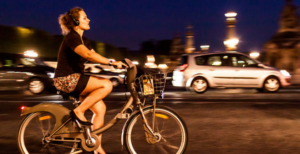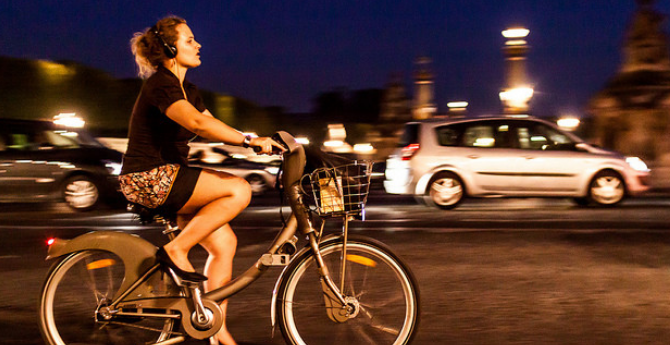Designing a high-efficiency bicycle for urban transport involves creating a lightweight, ergonomic, and practical vehicle tailored to city commuting. The goal is to make a bicycle that is fast, comfortable, durable, and suitable for navigating urban environments. Here’s a step-by-step guide:
1. Define Objectives
- Primary Purpose: Provide a cost-effective, eco-friendly, and efficient mode of urban transport.
- Target Audience: Commuters, students, and professionals in urban areas.
- Key Features: Lightweight design, compact storage, comfort for short and medium distances, and minimal maintenance.
2. Key Design Considerations
A. Frame Design
- Material:
- Aluminum: Lightweight, corrosion-resistant, and affordable.
- Carbon Fiber: Ultra-lightweight and strong but more expensive.
- Steel: Durable and cost-effective but heavier.
- Geometry:
- Focus on an upright riding position for comfort and visibility in traffic.
- Compact geometry for easy maneuverability in crowded urban areas.
- Features:
- Include attachment points for accessories like racks, fenders, and baskets.
B. Tires and Wheels
- Tire Type:
- Use puncture-resistant, hybrid tires for a balance of speed and durability on mixed surfaces.
- Width: 28-35mm for urban roads, providing a comfortable ride and good grip.
- Wheel Size:
- 700c (standard road bike size) for speed and efficiency.
- Smaller wheels (20-24 inches) for folding bikes or compact designs.
C. Drivetrain
- Options:
- Single-Speed: Low maintenance and lightweight, ideal for flat urban areas.
- Internal Gear Hub: Offers multiple gears with minimal maintenance, suitable for varied terrains.
- Derailleur System: Traditional multi-gear setup for hilly cities, though it requires more maintenance.
- Chain or Belt Drive:
- Chain Drive: Affordable and widely available.
- Belt Drive: Quieter, cleaner, and more durable, but more expensive.
D. Braking System
- Disc Brakes: Provide consistent stopping power in all weather conditions.
- Rim Brakes: Lightweight and cost-effective but less effective in wet conditions.
- Hydraulic vs. Mechanical:
- Hydraulic disc brakes offer better performance but are more expensive.
- Mechanical disc brakes are easier to maintain and more affordable.
E. Saddle and Handlebar
- Saddle:
- Ergonomic and cushioned for long-term comfort.
- Consider gel or memory foam padding for commuters.
- Handlebars:
- Flat or riser bars for an upright posture and better control.
- Drop bars for speed-focused commuters.
- Adjustable stems to customize handlebar height.
F. Lightweight and Foldable Design
- For urban environments with limited parking, consider foldable frames.
- Aim for a total weight of 10-15 kg to balance portability and durability.
G. Lighting and Safety
- Integrated LED Lights: Battery-powered or dynamo-powered lights for visibility.
- Reflective Elements: On tires, pedals, and frame for enhanced visibility.
- Bell or Horn: Essential for signaling in urban traffic.
H. Accessories
- Racks and Baskets: For carrying groceries or work essentials.
- Fenders: To protect riders from water and mud splashes.
- Kickstand: For convenient parking.
- Anti-Theft Features: Include frame-integrated locks or provisions for U-locks.
3. Efficiency Features
A. Aerodynamics
- Use a streamlined frame design to reduce air resistance.
- Minimize external attachments that create drag.
B. Weight Reduction
- Use lightweight components like carbon forks or aluminum alloy wheels.
- Avoid unnecessary features to keep the bicycle simple and efficient.
C. Energy Recovery (Optional)
- Consider regenerative braking systems for electric-assisted bicycles.
4. Optional Additions for Enhanced Urban Use
A. Electric Assist
- Motor Type: Hub motor (front or rear) or mid-drive motor.
- Battery: Lithium-ion battery with a range of 30-50 km for daily commuting.
- Pedal Assist: Include multiple levels of assistance for hilly terrain or long distances.
B. Smart Features
- GPS Tracking: Anti-theft and navigation features.
- Smartphone Integration: For route planning and performance tracking.
- Digital Display: Show speed, distance, and battery status (if electric).
5. Manufacturing and Materials
- Choose sustainable materials and processes to reduce environmental impact.
- Explore modular manufacturing to simplify repairs and replacements.
- Offer customization options for colors and features.
6. Testing and Validation
- Conduct durability and safety tests under various conditions (e.g., potholes, wet roads).
- Test ergonomics for different rider heights and weights.
- Optimize the drivetrain for smooth shifting and pedaling efficiency.
7. Cost and Pricing
- Low-Cost Version: $200–$500 using steel or aluminum frames with basic components.
- Mid-Range Version: $500–$1,000 with lightweight materials, internal gear hubs, and advanced brakes.
- Premium Version: $1,000+ featuring carbon frames, electric assist, and smart features.
8. Environmental and Social Impact
- Reduce urban congestion and pollution by promoting bicycle use.
- Design for recyclability to minimize waste.
- Provide affordable options for underserved communities.
Example Use Case
- Scenario: A commuter in a busy city needs a bicycle for daily travel within a 10 km radius.
- Solution: A lightweight aluminum-frame bicycle with 700c hybrid tires, an internal gear hub, disc brakes, a built-in rear rack, and integrated LED lights for safety.
Would you like help with specific technical details, such as frame geometry, drivetrain selection, or a conceptual sketch of the design?

Also Read :
